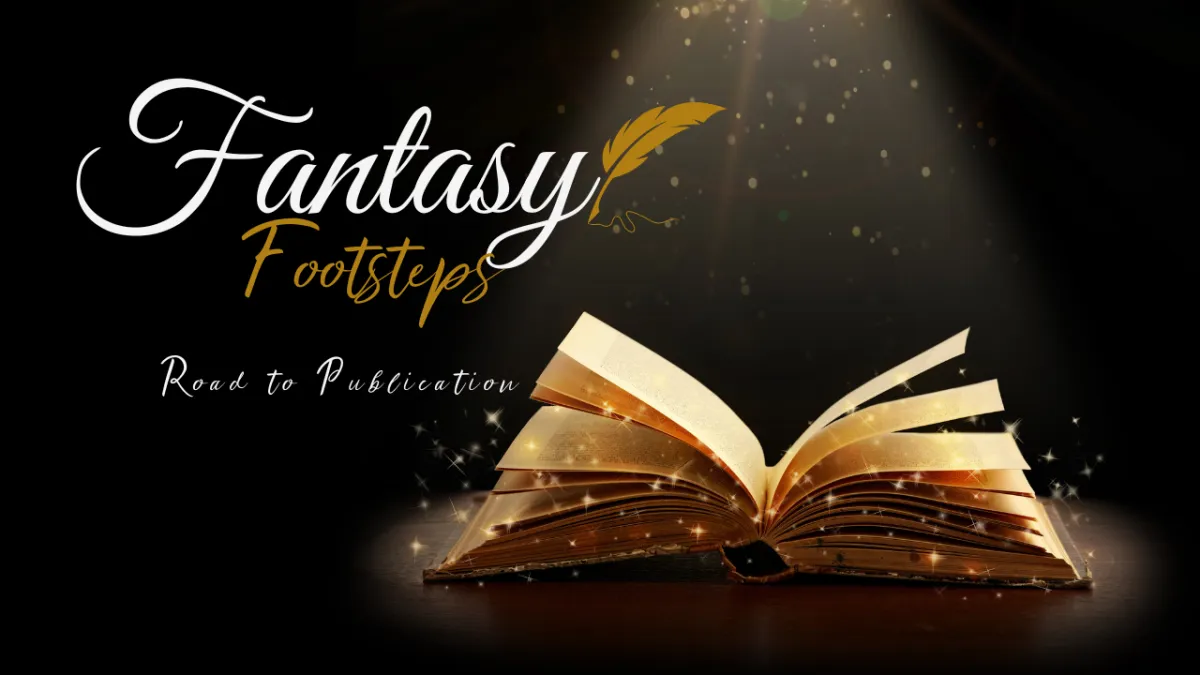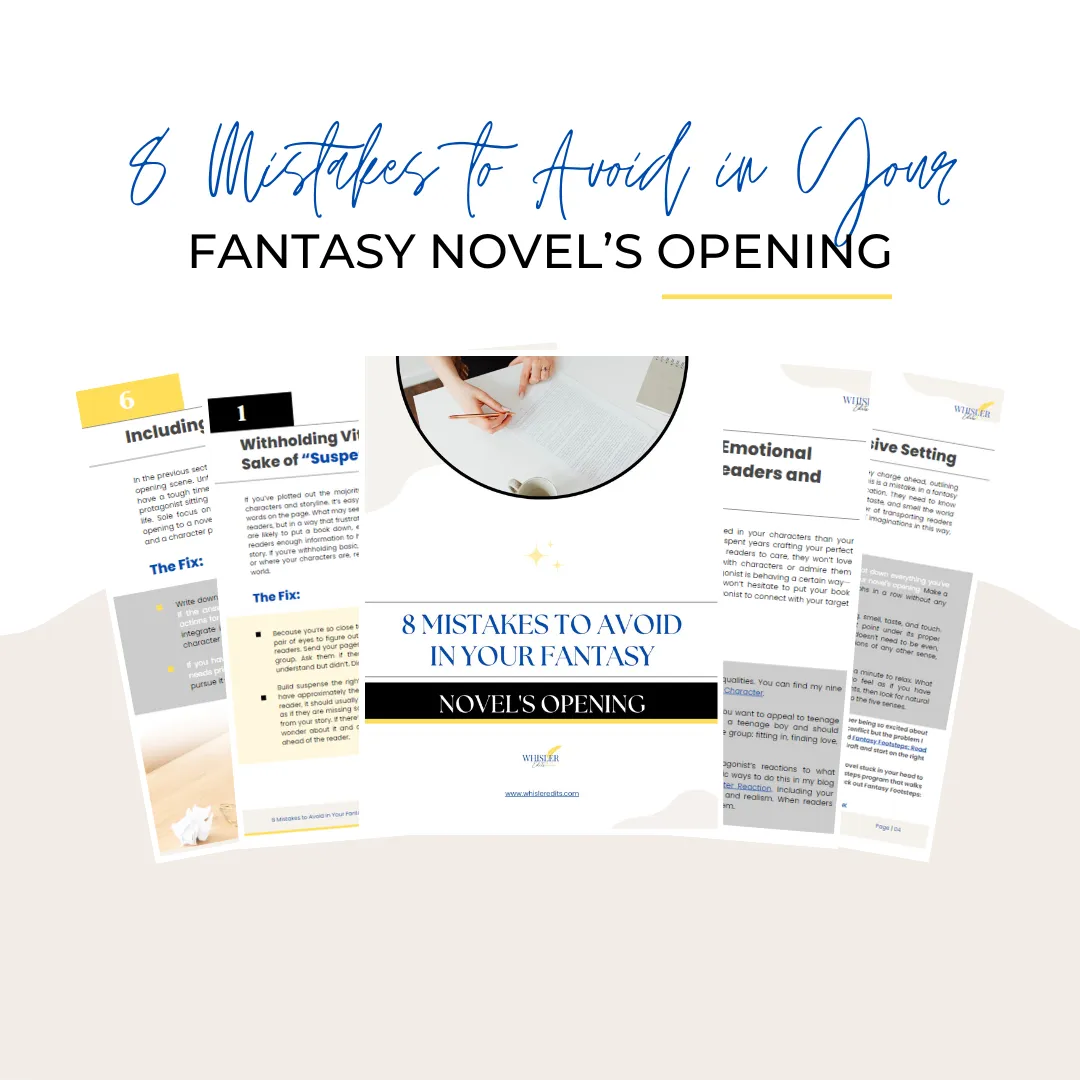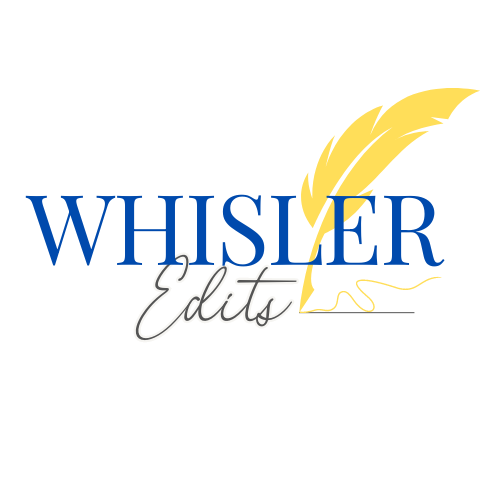8 Mistakes to Avoid
in Your Fantasy Novel’s Opening
Don’t let common mistakes lose your readers!

Your Novel Matters ...
Looking for the right book coach for your fantasy novel?
Are you a fantasy writer …
… struggling to convert the vivid scenes of your fantasy novel from your imagination to the page?
… stuck in a loop where you constantly rewrite your opening pages?
… worried your story won’t resonate with your readers?
What if I could show you the exact steps week to week that would take you from brainstorming and drafting to revising and publication?
I specialize in developmental editing and book coaching for writers of fantasy novels—writers who value the craft of storytelling and wish to create stories that resonate.
My Services
Develop Your Ideas
Fantasy Footsteps: Road to Publication

I’ll let you in on a secret. All you need to succeed as a writer are three things:
A Roadmap: Illuminate your path with a step-by-step guide, ensuring you achieve your writing goals every week. From outlining to publishing, every stage of your journey is mapped out for success.
Mindset Mastery: Learn how your thoughts control your outcomes in your writing. Overcome self-doubt and unearth the confidence that will bring your unique ideas to life on the page.
Personalized Support: Prepare for comprehensive assistance, real-time accountability, and feedback tailored to your needs. From brainstorming sessions to final publication, you'll have a dedicated ally guiding you every step of the way.
With these three pillars, you'll unlock the potential to:
Craft a captivating story that enthralls readers from the first page to the last.
Develop complex characters and immersive worlds that resonate deeply with your audience.
Navigate the complexities of plot twists and pacing, keeping readers hooked until the final chapter.
Receive specific guidance on refining your scenes so that readers root for your protagonist.
Overcome writer's block and stay motivated throughout your writing journey, ensuring consistent progress.
Transform your rough draft into a polished, professional manuscript ready for publication.
Are you ready to turn your fantasy novel from a mere vision into a masterpiece that captures hearts and minds?
Join Fantasy Footsteps: Road to Publication and begin your author journey with everything you need to write a story that works.
Don't let your story remain trapped in your mind—bring it to life with me!
If you’re thinking, “Yes, please! Tell me what to do!” , I’d like to invite you to work one-to-one with me to finish your novel and write a story that works. Join my book coaching program designed specifically for fantasy writers—Fantasy Footsteps: Road to Publication.

Discover Helpful Tools
Resources For Writers
Here you will find some of my favorite resources for writers.
Add these books, podcasts, websites, and other resources to your writing toolbox to augment your writing at any stage.
Join My Free, Private Facebook Group
Finish My Fantasy Novel: Write & Revise My Best Book in 6 Months
In the group, I go live weekly with writing tips. The group is also a platform for writers to support each other and share their wins and progress.
Live training schedule:
1st Tuesday of the month: Free critique for someone in the group!
2nd Tuesday of the month: Writing sprint with fellow writers
3rd Tuesday of the month: Live training on a specific topic
4th Tuesday of the month: Interview with an author or marketing/business expert


Improve Your Craft
Writing Advice Blog
As a developmental editor and book coach, everything I post is designed to help you build your creativity, strengthen your prose, and explore new avenues in your writing. The opinions in each post are my own, but many are inspired by ideas from established authors and editors who excel in their fields.
Rely on my blog for clear and specific writing advice, motivational tips and grammatical aid, and interviews with experts!
Hi! I'm Nicole.
I’m a Developmental
Editor & Book Coach for Fantasy Writers.
Like you, I'm a writer. I understand the mental and emotional ups and downs of storytelling. Don't let resistance win! Recognize the value of good advice plus hard work.
My approach to novel writing is multifaceted. For a deeper understanding of my process and style, take a look at some of my favorite craft-of-writing books in my Resources section.
What can I say about myself? I read, I write, I read about writing, and I write about reading. It never gets old to me.

See what writers like you are saying . . .

Nadir Shirazi
“I’ve been stalling on my Islam-inspired sci-fantasy series for 10 years. But within 10 minutes of starting Nicole’s program, I started writing again."

Amanda Emerick
“I can’t recommend Fantasy Footsteps enough to writers who are legitimately looking to polish their craft, write, and eventually publish their novel."

Trinity Cunningham
“I loved discussing my story with Nicole. She provided me with invaluable insights I never would have considered on my own."
Latest on the Blog

You will find no pictures of kittens here. No images of favorite dessert recipes, snapshots of my recent vacations, videos of puppies playing the piano (although I do love dogs), or YouTube clips of monkeys stealing people’s sunglasses.
I’m genuinely sorry if that disappoints you.
Instead, you can rely on my blog for clear and specific writing advice, motivational tips, grammatical aid, and author/editor interviews.
As a developmental editor & book coach, everything I post is designed to help you build your creativity, strengthen your prose, and explore new avenues in your writing. The opinions in each post are my own, but many are inspired by ideas from established authors and editors who excel in their fields.
Some of these tips might be just what you need to hear. Others might not work for you personally, and that’s okay.
Apply the tips that fit your personality and writing habits, and feel free to adapt or ignore the others. For further questions and comments, you can email me or reach me through my Contact page.

How to Use Flashbacks Effectively in Your Story
Discover in this post …
my thoughts on story content “rules.”
ways to determine whether a flashback is needed.
instances where you can replace flashbacks with alternative methods.
Rules, Schmules
The other day, one of my clients was concerned that the first section of his novel was out of proportion with the rest. He knew that I recommend the global inciting incident of a story (the big event that sets the main character on a new path) to occur somewhere around the 20% mark, and his inciting incident happened well before that.
I talked through his story with him, and I asked him the only question that matters:
“Will your readers feel that your beginning is rushed? Will they have time to get to know your main character and attach emotionally, or are you missing out on a vital opportunity to build that all-important connection between characters and readers?”
In my client’s case, he felt that he had accomplished those items in less time than it typically takes, but they were present regardless, so for him and his target readers, it wasn’t necessarily going to be an issue.
This brings up two important concepts that I always like to convey to writers:

If you hear someone talk about story content “rules,” consider referring to them in your mind as “guidelines” instead.
Every guideline that has ever existed in the writing world has been established for a reason. And when we take a closer look at the reason, taking into account our personal writing goals, it helps us understand whether it makes sense for us to follow the advice, disregard it, or “follow” it in our own creative (and perhaps unconventional) way.
Today, I’m going to share several guidelines with you that relate to when and how to use story flashbacks. If your goal as a writer is to create maximum emotional impact for readers anytime you use a flashback, you’re in the right place.
What's a Flashback?
In terms of story, Merriam Webster defines a flashback as an “interruption of chronological sequence by interjection of events of earlier occurrence.”
In other words, it’s a moment within your story in which you create a mini-scene or piece of a scene around something that happened prior, and you reveal it as if it’s happening in the moment. (If it’s not revealed this way, it’s technically just a memory, a character reflecting on a situation rather than a flashback.)
Think of the TV show Lost, where the writers chose to explore the backstories of the characters and portray bits of their former lives. In each episode, viewers learned more about who the characters were before they crashed onto the island.

Sometimes it really helped to know those characters’ backstories because it deepened the connection viewers felt with certain characters, or it shed light on something happening in the present. Other times, viewers weren’t happy with the way the flashbacks slowed down the story.
So how do you know when it’s a good idea to use a flashback in your story and when it would be better to go without?
Let’s look into that together. Below, you’ll find my top guidelines that will help you decide whether your flashback will add to your work in progress or take away from it.
When to Use Flashbacks
GUIDELINE 1: Your flashback should have a clear impact on the present story.
This is the most important point I can make about flashbacks.
If you’re striving to tell a powerful story that appeals to readers’ emotions, it doesn’t matter how artfully you write your flashback or how beautiful your language comes across.
If your flashback doesn’t seem to affect the current storyline, readers will (consciously or subconsciously) question why you included it. They might even be annoyed without realizing exactly why.
As an example, let’s say your protagonist had a horrible childhood, and you’d like to include one of their worst moments on the page. They were five years old and left abandoned at an old mall.
You might think to yourself, This is good stuff. Readers are going to be heartbroken over my character’s rough childhood—and that’s exactly where I want them to be.
If your flashback connects with the modern-day story and provides clear insights into why your character is acting a certain way or making a specific decision, you might be fine. Readers will make the connection and understand why you included the flashback. It will help them make sense of your protagonist.
On the other hand, if the flashback appears random to readers and they can’t decipher why you included it, you’re in danger of losing reader trust.

GUIDELINE 2: Your flashback should shed light on something important and new, something readers weren’t aware of until this point in your story.
The word “important” is key here. As the writer, you probably have stacks of notes about each of your characters—but just because you know a great deal of information does not mean readers need to know it all too.
If you think a certain character’s backstory is interesting, great! Ask yourself, Do readers need to know this in order to understand the story, or am I including this simply because I worked hard on this backstory and don’t want to waste it?
GUIDELINE 3: Flashbacks can be appropriate and effective in the case of unconventional timelines.
If you’re writing a story in which the past and present are equally important and clearly relate to each other, half your story might come across as a flashback. Writers of mystery and suspense often use this technique, and it can be a powerful one, but only if suspense is present in both sections of the story. You want to capture your readers’ attention throughout the entire book, not have readers slowing down (or worse, skipping pages!) during one section of your story so that they can get back to the “good part.”
When to Avoid Flashbacks
GUIDELINE 1: Avoid flashbacks when you’re only using them because you can’t think of another way to convey information about a character.
Our writer’s brain likes to feed us interesting ideas that aren’t necessarily true. One of these lies is “There’s no other way to incorporate this exposition than to add a quick flashback. That way, readers will understand the whole picture.”
If this is you, I challenge you to expand your realm of possibility by jotting down all the different ways you can incorporate a character’s backstory.
“But I just told you,” you might say, “that I only used the flashback because I couldn’t think of another way to get the information across. So how am I supposed to come up with more ideas?”
Right. I get what you’re saying. But now I’m telling you that the reason you came up with only one idea is that you decided there was only one idea—just one possibility.
Now that I’m telling you there are more, convey that idea to your brain and watch as it creates additional possibilities, such as internal thoughts, external dialogue, and subtext. Each can deliver background to readers in place of a flashback.
GUIDELINE 2: Avoid lengthy flashbacks.
Unless you’re using an unconventional timeline (as described in Guideline 3 in the section above), keep your flashback concise so that the impact is clear and powerful. If you draw out a flashback, it can easily distract from the main plot.
GUIDELINE 3: Avoid overusing flashbacks.
Even if all your flashbacks serve a strong purpose and shed light on something interesting about your present-day character, ask yourself where you’d like to place the focus of your story. Do you want to emphasize the past and present equally, as explained in Guideline 3 in the section above? Or do you want readers to focus on the present story? If the latter, you’ll want to avoid using flashbacks too often. Overusing them only makes your story lag and slows readers down.
Bonus Test
I know someone who doesn’t believe in using flashbacks at all. He thinks everything should take place in the present in your story to keep it tight and the pacing on point. Although I wouldn’t go to that extreme, if you’re still debating whether your flashback is necessary after reading the above items, I encourage you to conduct this “bonus test”:
If in doubt, take it out.

Then see how your story reads without it. If removing it has a negative impact on readers’ understanding of your plot or characters, you might want to keep it. But if taking it out gives you a clear idea of how to integrate a few key details without the full flashback, so much the better.
Summing Up
As a reminder, when you’re deciding whether or not to use a flashback, consider the following:
Flashback Do’s:
Your flashback should have a clear impact on the present story.
Your flashback should shed light on something important and new, something readers weren’t aware of until this point in your story.
Flashbacks can be appropriate and effective in the case of unconventional timelines.
Flashback Don’ts:
Avoid flashbacks when you’re only using them because you can’t think of another way to convey information about a character.
Avoid lengthy flashbacks.
Avoid overusing flashbacks.
Did today’s post help you decide whether or not you should use flashbacks in your work in progress? Did it bring up any items you’d never considered before? What’s your own opinion on flashbacks? I’d love for you to email me and let me know at [email protected]. Here’s to a productive writing week ahead!
Do you want to learn how to write a story that makes your target readers stand up and cheer? If you’d like support from A to Z (from brainstorming to drafting to revising to publication), book a Discovery Call with me to see if you’re a good fit to join my book coaching program, Fantasy Footsteps: Road to Publication. And if you haven’t done so already, grab your Free Guide on how to hook readers from your story’s start!

Capture Your Readers from Your First Scene
Download my exclusive guide—8 Mistakes to Avoid in Your Fantasy Novel’s Opening. Start your fantasy novel right!
Are you worried you've failed to establish a bond between readers and characters in your first chapter? Do you wonder if you've bogged readers down with your worldbuilding? Do you sometimes overlook essential conflicts? Many readers will put your book down if it doesn't grab their attention right away, so it's vital to evoke powerful emotions from readers as early as possible.
Don't let these common mistakes rob your story of its magic and momentum. Save your precious time and energy by ensuring you hook readers from the start. Grab your guide now and check your opening against these common missteps!
(You will also receive monthly writing advice, updates about my free live trainings, and direct access to replays. Unsubscribe anytime.)

